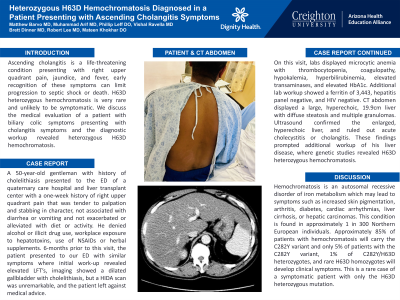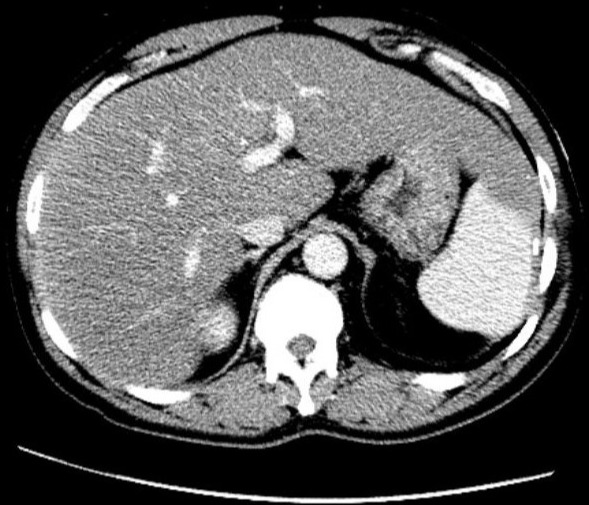Sunday Poster Session
Category: Liver
P1023 - Heterozygous H63D Hemochromatosis Diagnosed in a Patient Presenting with Ascending Cholangitis Symptoms
Sunday, October 22, 2023
3:30 PM - 7:00 PM PT
Location: Exhibit Hall

Has Audio

Matthew M. Barvo, MD
Creighton University
Phoenix, AZ
Presenting Author(s)
Matthew M. Barvo, MD1, Muhammad Arif, MD1, Phillip Leff, DO2, Vishal Ravella, MBBS1, Brett A. Dinner, MD1, Robert Lee, MD1, Mateen Khokhar, DO3
1Creighton University, Phoenix, AZ; 2Creighton University, Scottsdale, AZ; 3St. Joseph's Hospital and Medical Center, Phoenix, AZ
Introduction: Ascending cholangitis is a life threatening condition presenting with right upper quadrant pain, jaundice, and fever, early recognition of these symptoms can limit progression to septic shock or death. H63D heterozygous hemochromatosis is very rare and unlikely to be symptomatic. We discuss the medical evaluation of a patient with biliary colic symptoms presenting with cholangitis symptoms and the diagnostic workup revealed heterozygous H63D hemochromatosis.
Case Description/Methods: A 50-year-old gentleman with history of cholelithiasis presented to the ED of a quaternary care hospital and liver transplant center with a one week history of right upper quadrant pain that was tender to palpation and stabbing in character, not associated with diarrhea or vomiting and not exacerbated or alleviated with diet or activity. He denied alcohol or illicit drug use, workplace exposure to hepatotoxins, use of NSAIDs or herbal supplements. 6-months prior to this visit, the patient presented to our ED with similar symptoms where initial work-up revealed elevated LFT’s, imaging showed a dilated gallbladder with cholelithiasis, but a HIDA scan was unremarkable and the patient left against medical advice. On this visit, labs displayed microcytic anemia with thrombocytopenia, coagulopathy, hypokalemia, hyperbilirubinemia, elevated transaminases, and elevated HbA1c. Additional lab workup showed a ferritin of 3,443, hepatitis panel negative, and HIV negative. CT abdomen displayed a large, hyperechoic, 19.9cm liver with diffuse steatosis and multiple granulomas. Ultrasound confirmed the enlarged, hyperechoic liver, and ruled out acute cholecystitis or cholangitis. These findings prompted additional workup of his liver disease, where genetic studies revealed H63D heterozygous hemochromatosis.
Discussion: Hemochromatosis is an autosomal recessive disorder of iron metabolism which may lead to symptoms such as increased skin pigmentation, arthritis, diabetes, cardiac arrhythmias, liver cirrhosis, or hepatic carcinomas. This condition is found in approximately 1 in 300 Northern European individuals. Approximately 85% of patients with hemochromatosis will carry the C282Y variant and only 5% of patients with the C282Y variant, 1% of C282Y/H63D heterozygotes, and rare H63D homozygotes will develop clinical symptoms. This is a rare case of a symptomatic patient with only the H63D heterozygous mutation.

Disclosures:
Matthew M. Barvo, MD1, Muhammad Arif, MD1, Phillip Leff, DO2, Vishal Ravella, MBBS1, Brett A. Dinner, MD1, Robert Lee, MD1, Mateen Khokhar, DO3. P1023 - Heterozygous H63D Hemochromatosis Diagnosed in a Patient Presenting with Ascending Cholangitis Symptoms, ACG 2023 Annual Scientific Meeting Abstracts. Vancouver, BC, Canada: American College of Gastroenterology.
1Creighton University, Phoenix, AZ; 2Creighton University, Scottsdale, AZ; 3St. Joseph's Hospital and Medical Center, Phoenix, AZ
Introduction: Ascending cholangitis is a life threatening condition presenting with right upper quadrant pain, jaundice, and fever, early recognition of these symptoms can limit progression to septic shock or death. H63D heterozygous hemochromatosis is very rare and unlikely to be symptomatic. We discuss the medical evaluation of a patient with biliary colic symptoms presenting with cholangitis symptoms and the diagnostic workup revealed heterozygous H63D hemochromatosis.
Case Description/Methods: A 50-year-old gentleman with history of cholelithiasis presented to the ED of a quaternary care hospital and liver transplant center with a one week history of right upper quadrant pain that was tender to palpation and stabbing in character, not associated with diarrhea or vomiting and not exacerbated or alleviated with diet or activity. He denied alcohol or illicit drug use, workplace exposure to hepatotoxins, use of NSAIDs or herbal supplements. 6-months prior to this visit, the patient presented to our ED with similar symptoms where initial work-up revealed elevated LFT’s, imaging showed a dilated gallbladder with cholelithiasis, but a HIDA scan was unremarkable and the patient left against medical advice. On this visit, labs displayed microcytic anemia with thrombocytopenia, coagulopathy, hypokalemia, hyperbilirubinemia, elevated transaminases, and elevated HbA1c. Additional lab workup showed a ferritin of 3,443, hepatitis panel negative, and HIV negative. CT abdomen displayed a large, hyperechoic, 19.9cm liver with diffuse steatosis and multiple granulomas. Ultrasound confirmed the enlarged, hyperechoic liver, and ruled out acute cholecystitis or cholangitis. These findings prompted additional workup of his liver disease, where genetic studies revealed H63D heterozygous hemochromatosis.
Discussion: Hemochromatosis is an autosomal recessive disorder of iron metabolism which may lead to symptoms such as increased skin pigmentation, arthritis, diabetes, cardiac arrhythmias, liver cirrhosis, or hepatic carcinomas. This condition is found in approximately 1 in 300 Northern European individuals. Approximately 85% of patients with hemochromatosis will carry the C282Y variant and only 5% of patients with the C282Y variant, 1% of C282Y/H63D heterozygotes, and rare H63D homozygotes will develop clinical symptoms. This is a rare case of a symptomatic patient with only the H63D heterozygous mutation.

Figure: CT image demonstrating hyperechoic parenchyma, measuring 19.7cm in length
Disclosures:
Matthew Barvo indicated no relevant financial relationships.
Muhammad Arif indicated no relevant financial relationships.
Phillip Leff indicated no relevant financial relationships.
Vishal Ravella indicated no relevant financial relationships.
Brett Dinner indicated no relevant financial relationships.
Robert Lee indicated no relevant financial relationships.
Mateen Khokhar indicated no relevant financial relationships.
Matthew M. Barvo, MD1, Muhammad Arif, MD1, Phillip Leff, DO2, Vishal Ravella, MBBS1, Brett A. Dinner, MD1, Robert Lee, MD1, Mateen Khokhar, DO3. P1023 - Heterozygous H63D Hemochromatosis Diagnosed in a Patient Presenting with Ascending Cholangitis Symptoms, ACG 2023 Annual Scientific Meeting Abstracts. Vancouver, BC, Canada: American College of Gastroenterology.
